Adventure enduro is a holistic discipline. It revolves through the same cycles of preparation, riding and planning the next adventure. Throughout the process, the bike, riding gear and other equipment are continuously perfected. Each day of riding gives more insight; equipment either works or it needs to be rethought. High quality gear, that performs reliably under extreme conditions, is of paramount importance in running successful expeditions.
THE BARE NECESSITIES
Toolkits are as varied as the riders who carry them. Looking into the matter a few years back, the scale stretched from an adventure enduro dude cutting and welding spanners together to a RTW guy insisting on carrying all tools for a full engine rebuild. Needless to say my views are closer to the former gentleman and that the latter fellow probably needs a reality check, a more reliable bike or both.
My philosophy with all gear is to ride as light as possible and bring only the bare necessities. The real question, however, is how to define “necessities”. Unsurprisingly the answers are as diverse as the riders. For me, a necessity is a piece of equipment that needs to be onboard to ensure the continuation of the ride in the event of a failure. This applies rigidly to all tools and spare parts. So a spare fuel pump, throttle cables and e.g. a shifter pedal are necessities, but a spare headlight bulb or a brake pedal aren’t. However the likelihood of a specific catastrophic malfunction also plays into the equation of defining a necessity. The probability of a fuel pump failure crosses the line but a cracked cylinder head doesn’t, so only the former is carried. The definition of necessities affects what spare parts are carried, which in turns specifies what tools are needed.
Another thing to consider is what work you should actually be prepared to do in the field. To continue riding, a toasted clutch will have to be replaced and a flat tire fixed on the field. On the the hand, normal scheduled and non-critical service such as valve adjustment, oil changes and replacing wheel bearings are better left for friendlier environments, where you can find bigger and perhaps more special tools and avoid having to carry them. This streamlines the toolkit and also reduces the risk of potentially harmful engine contamination by airborne debris. On the 500 EXC a good example is valve adjustment; the valve cover needs to be off for a while and the breather hose clamp is a right bitch to get back on without a large flat head screwdriver or the official clamp pliers. Both tools are large, heavy and needed for one thing only, so I don’t carry them. Instead I do that kind of work at roadside garages, which are plentiful in most parts of the world and in most cases welcome foreigners on adventure enduro bikes with open arms.
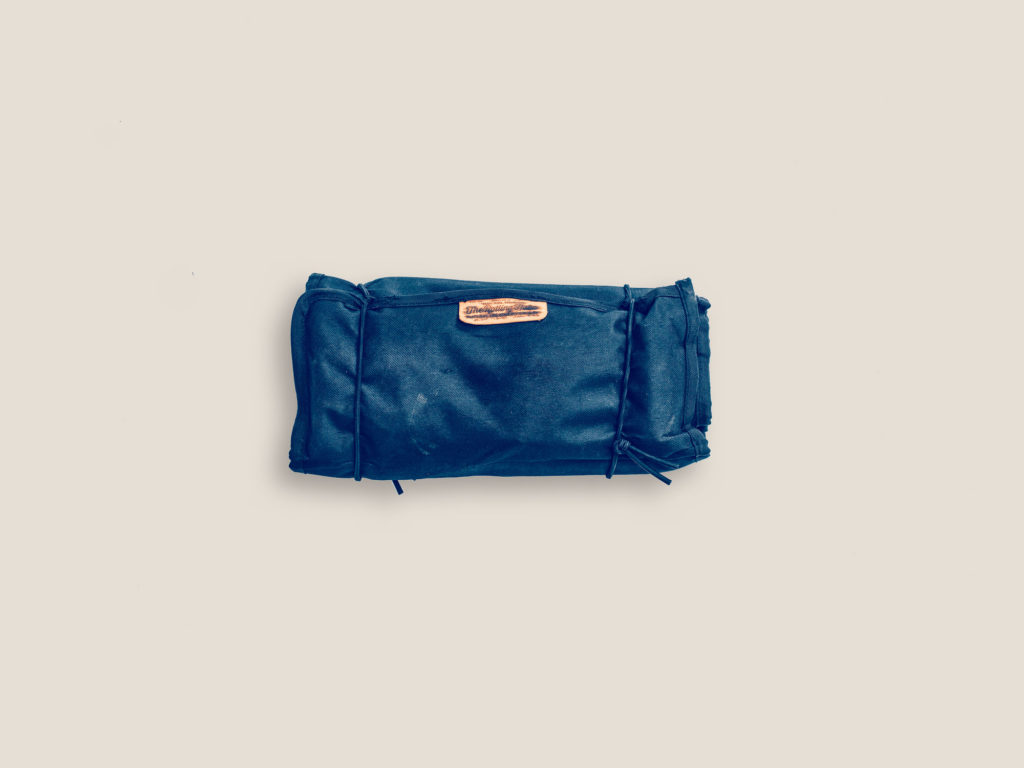
THE TOOL ROLL
The toolkit is absolutely essential for continuing the ride in the event of a failure, and without it spare parts are useless. Therefore the toolkit must never be put into a position where it can be lost during the ride. Storing it into a pannier is less risky than say a bolt-on tool tube on the frame of the bike.
All my stuff currently rides in a cheap tool roll I found on eBay and modified to carry what I need. Basically I just opened up the stitches between some of the slots to make room for my electronic multimeter and chain tool. I also made some Cordura pouches to organize and carry tool bits, 1/4″ and 3/8″ sockets and adapters. They have velcro closures and another velcro to secure them onto the tool roll while giving easy access to the tools. The tool roll came quipped with ridiculously long and dodgy webbing for closing it. I replaced them with heavy duty bungee cords to secure the tool roll when it’s closed. I find the smallest irritations can snowball into monsters on the trail, so it’s better to snip them in the bud if you can. In this case it meant running some extra stitching across the tool slots to have them sit at the correct height and thus avoid ever having to fish for the tools in the field.
I’ve been very strict with never carrying any fluids inside my panniers. With the ultralight setup I decided to break this rule; the tool roll contains thread locker, grease, adhesive, tyre powder etc. They are nasty substances and carry a risk of contaminating camping gear if there is damage to the containers. The way I see it though is that in the field it’s better to have all necessary tools and consumables in one place and easily accessible, instead of several locations around the bike. It’s a real nuisance and risk having to dig around your panniers for a puncture kit when the bike is propped up on a dodgy pile of rocks and the rear wheel is already off. Anyhow, all fluids and powders are double bagged in 90 μm heavy duty zip lock bags and are inside the zippered compartment of the tool roll, which rides at a 45 degree angle at the bottom of my left hand side 15 litre pannier. So in the unlikely event of a container bursting and the liquid running through two plastic barriers and the tool roll, it should end up in the bottom of the pannier without contaminating anything. As a precaution though, I’ve made ultralight waterproof pouches for all my camping gear and will do so also for the tool roll.
Anyhow, the tool roll is not pretty, but it’s functional and very affordable. The life of a tool roll is rather grueling as it spends its time either laid out on dirt or mud or suffers from constant abrasion, greasy tools and oily hands. So I don’t mind the ghetto look. The biggest issue I have with the tool roll is its weight; 382 g including the pouches when empty. That is a lot for a minimalist and I’m currently looking into making an ultralight version with light materials on the inside and maybe just a thin waterproof Cordura on the back.
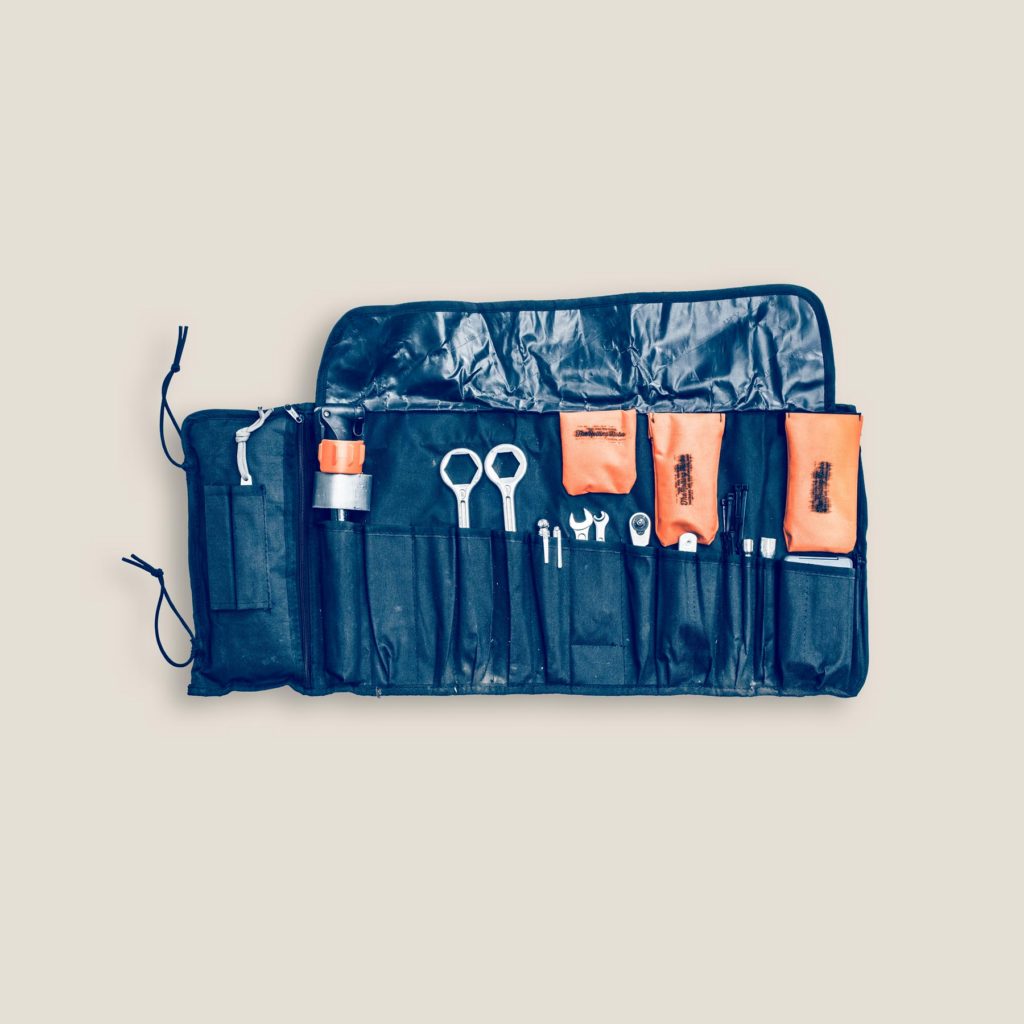
WHAT’S IN THE ROLL
- Bead buddy Trail, 1 pcs, 18 g
- Bit, hex 3 mm, 1 pcs, 4 g
- Bit, hex 4 mm, 1 pcs, 5 g
- Bit, hex 5 mm, 1 pcs, 6 g
- Bit, hex 6 mm, 1 pcs, 7 g
- Bit, Screwdriver, Flat 5.5 mm, 1 pcs, 5 g
- Bit, Screwdriver, Philips, 1 pcs, 5 g
- Bit, Torx 10 drilled, 1 pcs, 3 g
- Bit, Torx 15, 1 pcs, 4 g
- Bit, Torx 20, 1 pcs, 5 g
- Bit, Torx 25, 1 pcs, 6 g
- Bit, Torx 30, 1 pcs, 8 g
- Chain breaker tool, 1 pcs, 294 g
- Electric multimeter, 1 pcs, 126 g
- Feeler gauges 0.05 -0.35, 1 set, 8 g
- Fork seal doctor, 1 pcs, 16 g
- Fuel tank hose connector plugs, 1 pcs, 6 g
- Leatherman SuperTool, 1 pcs, 286 g
- Magnet, 1 pcs, 36 g
- Pressure stick, 1 pcs, 16 g
- Pump, MTB Handle, 1 pcs, 168 g
- Socket, 1/2” 17 mm, 1 pcs, 64 g
- Socket, 1/2” 19 mm, 1 pcs, 76 g
- Socket, 1/4” 06 mm, 1 pcs, 10 g
- Socket, 1/4” 07 mm, 1 pcs, 12 g
- Socket, 1/4” 08 mm, 1 pcs, 12 g
- Socket, 1/4” 10 mm, 1 pcs, 16 g
- Socket, 1/4” 11 mm, 1 pcs, 20 g
- Socket, 1/4” 12 mm, 1 pcs, 22 g
- Socket, 1/4” 13 mm, 1 pcs, 26 g
- Socket, 1/4” Bit adapter, Bahco, 1 pcs, 16 g
- Socket, 1/4” Hex 8 mm, 1 pcs, 20 g
- Socket, 1/4” T45, 1 pcs, 18 g
- Socket adapter, 3/8” Motion Pro, 1 pcs, 33 g
- Socket adpater, 3/8” => 1/2”, 1 pcs, 44 g
- Socket adpater, 3/8” => 1/4”, 1 pcs, 20 g
- Socket, spark plug KTM 500, 1 pcs, 30 g
- Spanner, 10/13 KTM, 1 pcs, 52 g
- Spanner, 7/10 KTM, 1 pcs, 48 g
- Spanner, ratchet, Bahco 1/4” , 1 pcs, 136 g
- Spanner, ratchet extender, Bahco 1/4” , 1 pcs, 44 g
- Spanner, tyre spoon Motion Pro T-6 27 mm, 1 pcs, 90 g
- Spanner, tyre spoon Motion Pro T-6 32 mm, 1 pcs, 82 g
- Tool roll and tool bags, 1 pcs, 382 g
- Cable ties, 1 pcs, 16 g
- Electrical wire, 1 pcs, 58 g
- Grease, 1 pcs, 32 g
- Loctite, blue 243, 5 ml, 1 pcs, 14 g
- Loctite, green 2701, 10 ml, 1 pcs, 18 g
- Needle, thread and safety pins, 1 pcs, 4 g
- Puncture kit, 1 pcs, 44 g
- Silicone grease, 1 pcs, 20 g
- Tape, electrical, 1 pcs, 28 g
- Tape, gaffer, 1 pcs, 36 g
- Tyre powder 50 ml, 1 pcs, 44 g
- Fuse 10 A, 1 pcs, 3 g
- Fuse 7.5 A, 1 pcs, 3 g
Total weight 2.63 kg
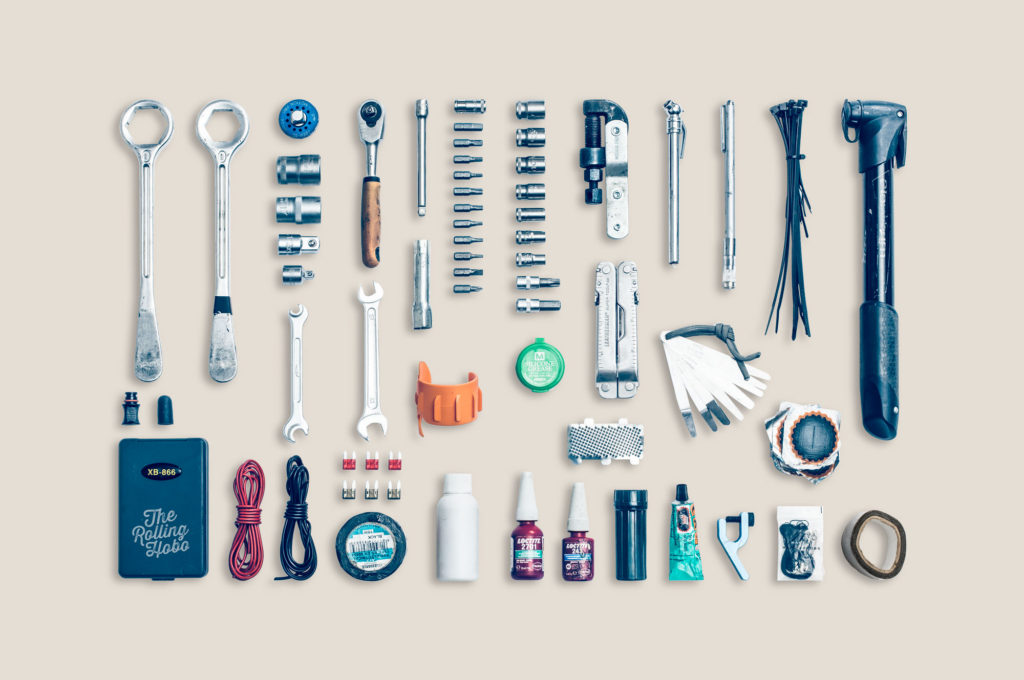
relentless
The contents may leave a bit of questions and some may scoff at the extensive lineup being called minimal. The obvious thing is the monstrously large and heavy Leatherman SuperTool, but the thing is that it actually lives in my CamelBak, rather than inside the toolkit. It’s actually pretty handy since it negates the necessity to carry a file, needle nose pliers and a blade, and it’s also quickly accessible for the small odd jobs one needs to deal with every now and then. Another one is the the fact that I carry 1/2″ sockets instead of 3/8″ which would fit directly on the MotionPro T-6 3/8″ socket adapter. The reason is that adding the 3/8″-1/2″ adapter between the socket and the spanner gives just enough clearance to comfortably work on the front sprocket bolt. Additionally the point of carrying the 3/8″ to 1/4″ adapter is to have a little bit of redundancy in case the 1/4″ ratchet breaks or if something needs a bit more leverage to open.
As stated earlier, equipment is a journey of continuous improvement, and this toolkit is far from perfect. For one it’s too heavy, both in terms of the containers and certain tools. The chain tool is very heavy for what it does and I’m looking into replacing it with a Motion Pro Light Weight Chain Breaker and Chain Press Tool, which will also work for pressing the slide plates on the chain links.
One thing I’m sometimes missing is locking adjustable pliers, but so far I have not been able to justify the added weight. An option would be to sacrifice the Leatherman SuperTool for the pliers, but I’d then need to add a few more tools to make up for the gap, and the weight might eventually go up. Ideally I’d like to get the toolkit and consumables to below 2 kg.
All comments, suggestions and criticism is most welcome. Conversation and debate, even heated, will improve us all.
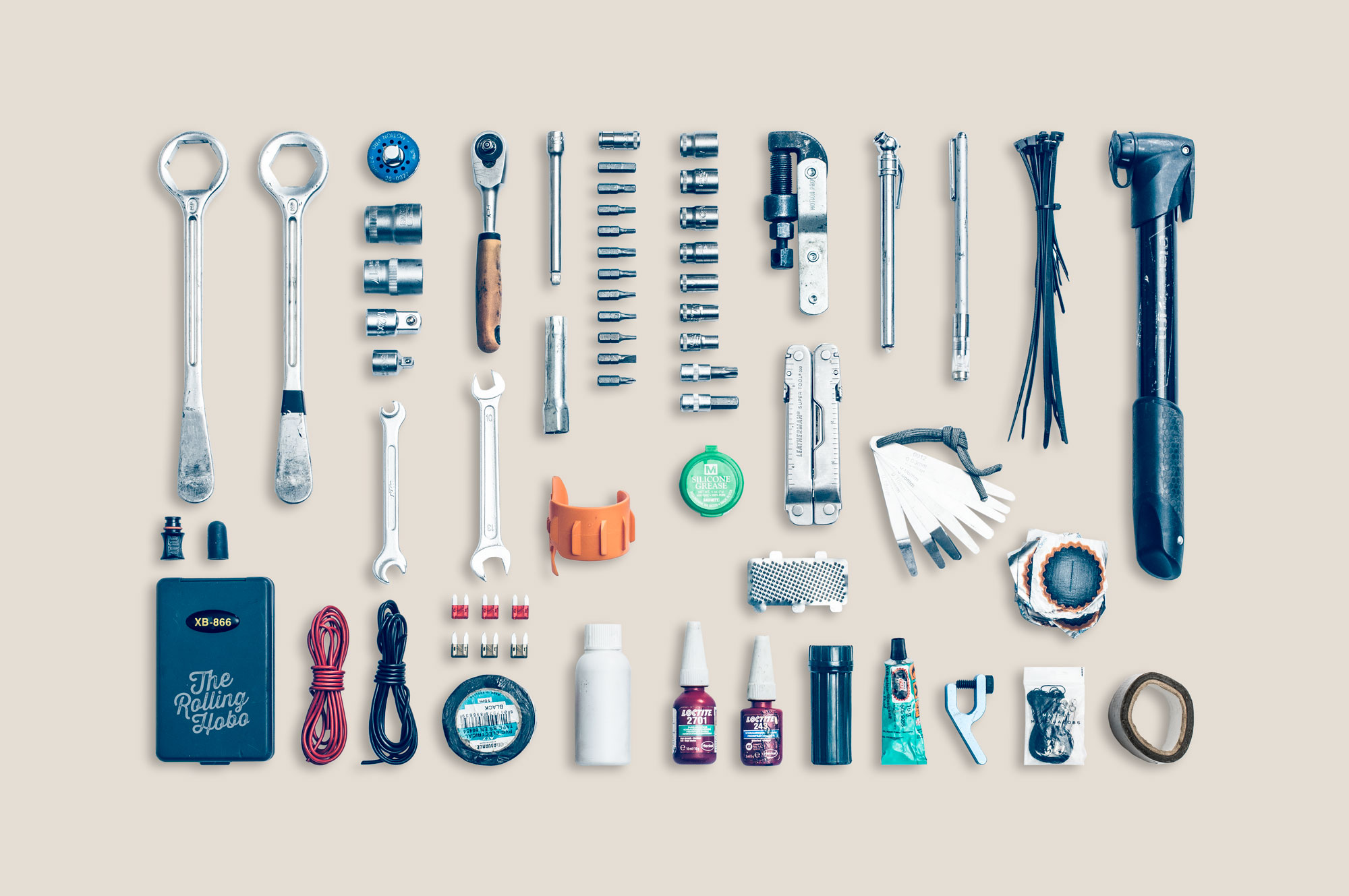
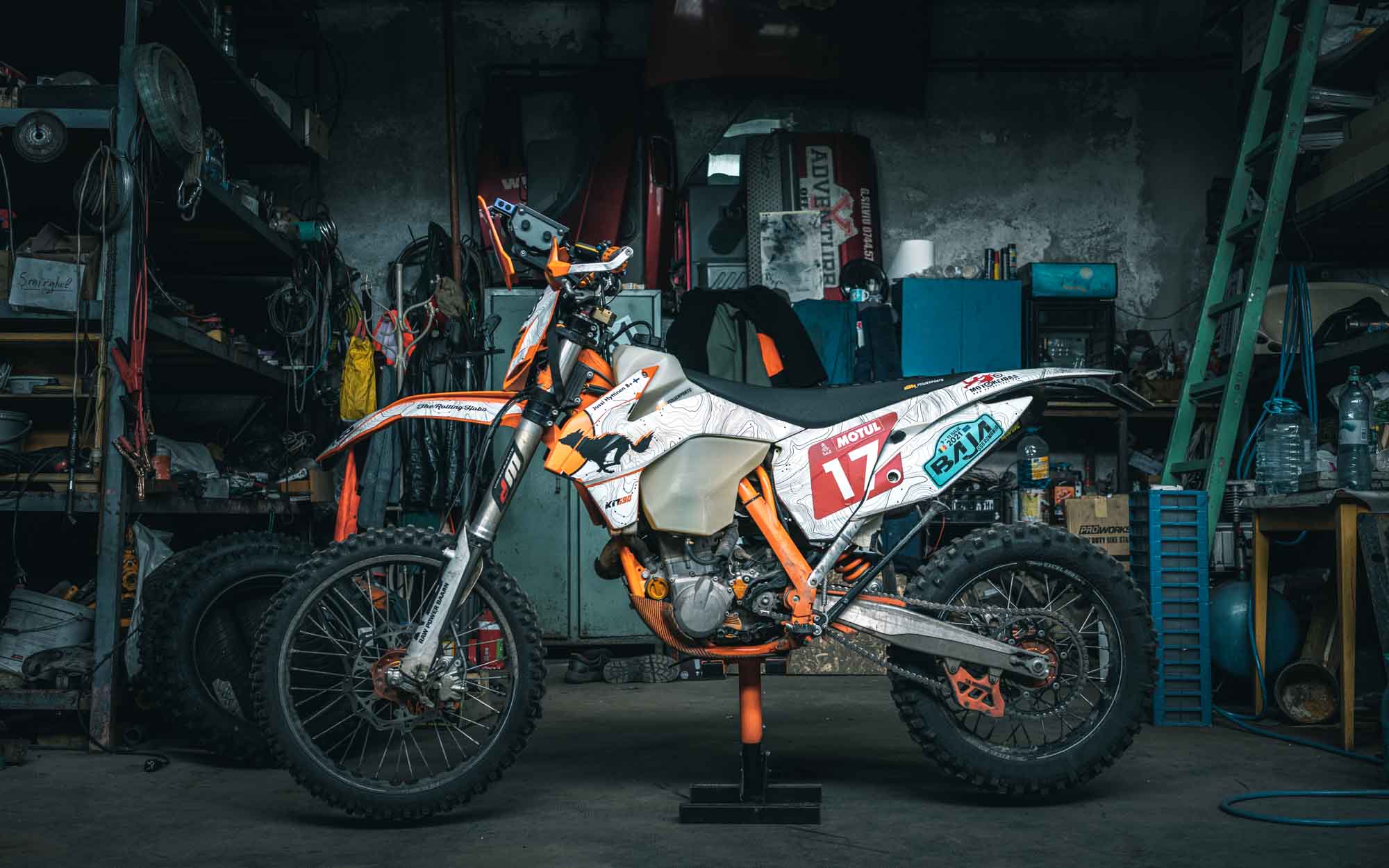
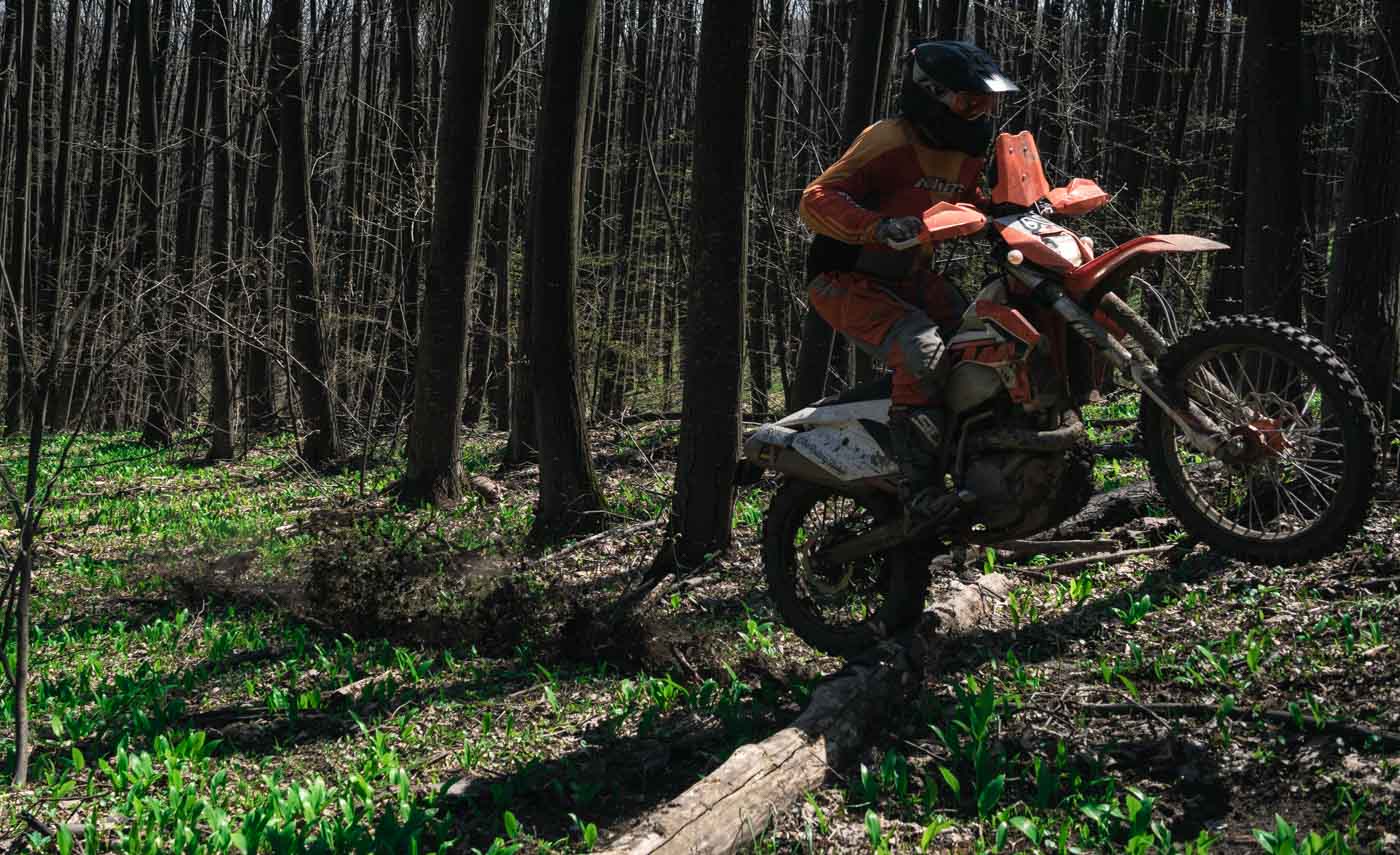
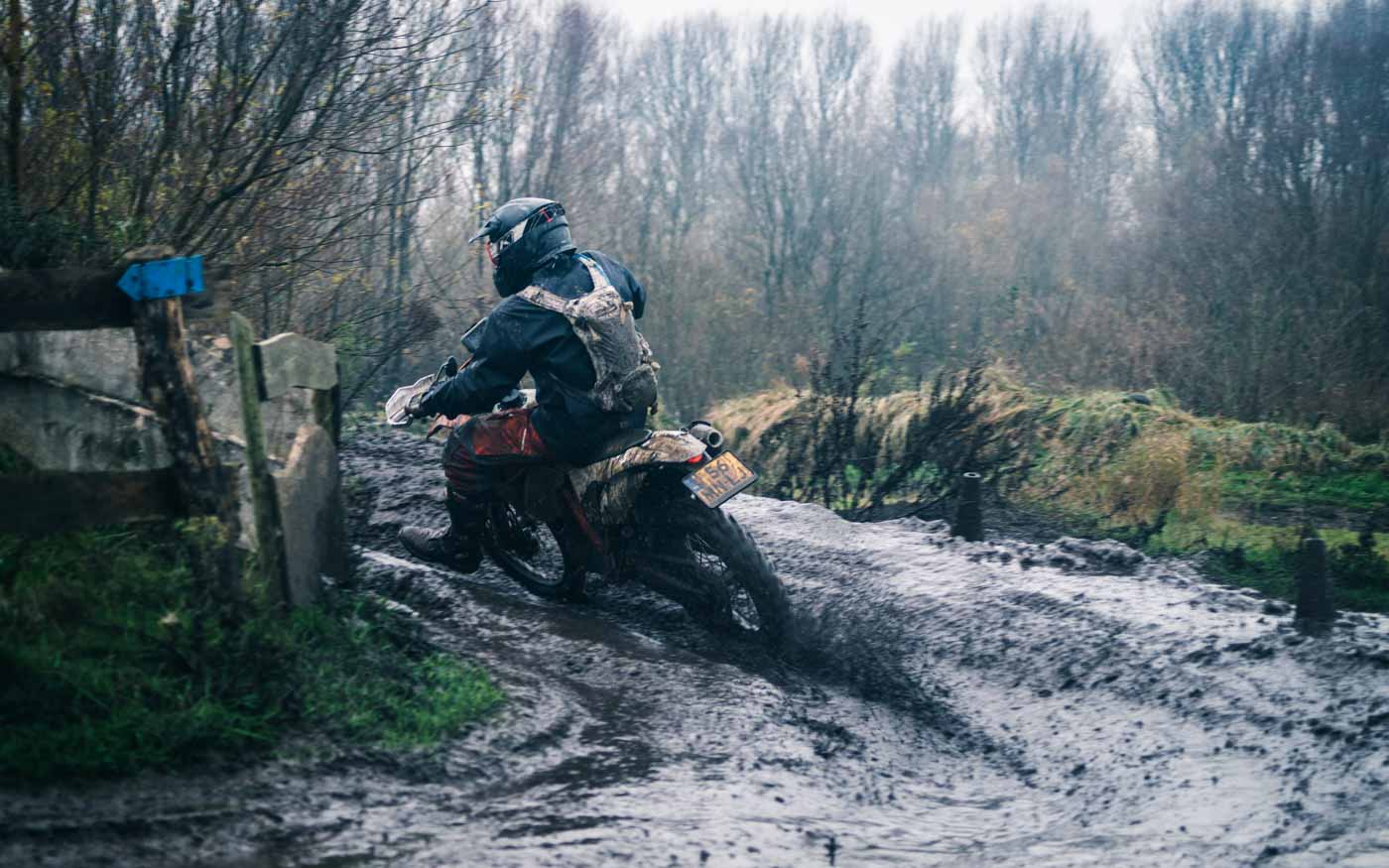
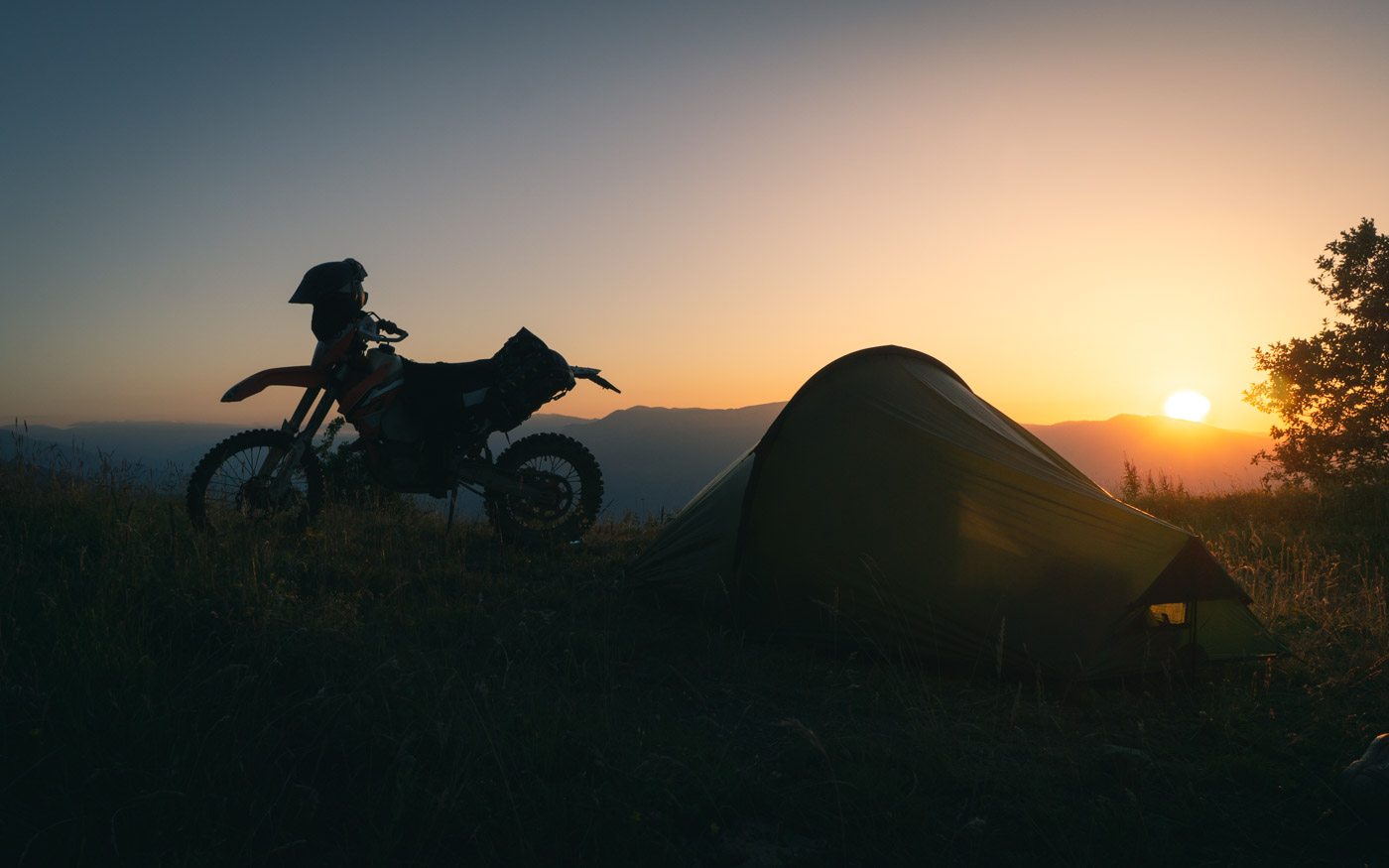
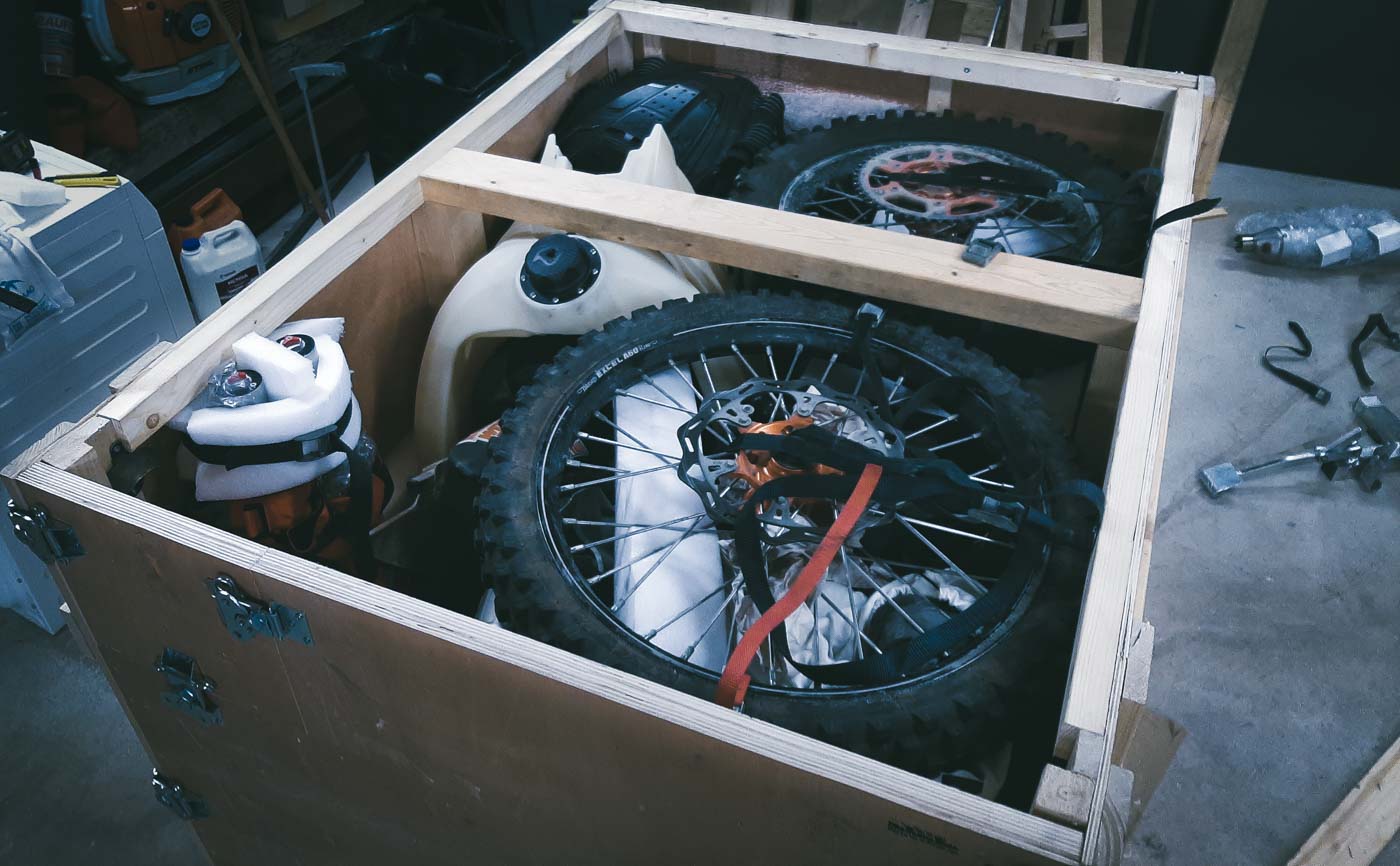
That’s a really good article and a thoughtful approach to a universal dilema. I almost feel embarrassed to have some of the things I take in my toll roll and there are a few things you’ve listed that I’m going to add. Whatever you take, the question still remains as to whether you could actually fix the bike even if you had the tools! A bead buddy and patches are great to fix a puncture, but if you’re on your todd like I was today and really don’t fancy taking the rear wheel out in the middle of a forest and are happy to ride to a village with the tyre flat, you’re just adding weight! Cheers anyway!
Everything with bikes is an evolution I suppose and we’ve all gone the same route of too much gear. I fully agree with what you’re saying about what you could actually fix with what you have. Some things are nice and simple in the workshop but get pretty miserable and tricky in the field if the weather and terrain aren’t cooperating and you’re worn from the riding.
Thank you for the article and ideas since I’m always jostling with my small day ride kit and my multi day trip, but yours might be my happy medium… cheers
Great article! I was just about to build a new toolkit and you saved me some research. Cheers!
Thanks! Do let us know what your final kit ends up consisting of…
the blue MP insert is also can act as a 1/4″ to 3/8″ adapter.
Hiya bud, thanks for the tip. I’d actually never noticed it before. It’ll be handy for using the 1/4″ ratchet on the 1/2″ sockets…
Hi Jussi…
Good to see you are ever and ever optimising.
I carry similar of tools although I use a strap that I carry anyway for multiple purposes instead of a bead buddy, I have fever bits, and I updgraded the motion pro chain tool to a heavier more heavy duty variant as I repeatedly broke the aluminium inserts on the motion pro version.
My tool roll comes in at 2.5kg…well…now it comes in at 0kg because that and all of my luggage including panniers, spare parts, leatt brace, camping gear etc was stolen in a private garage in a Auckland NZ. But that’s a different story.
Needless to say that I on my RTW (1/2) carried more spare parts. But also there a lesson learned as literally everything was somehow fixable along the way (including rebuilding the starter in Kazakhstan) except for the rear shock which I had to replace. So on my hopefully second part of my ride I will repack considerably.
Safe riding!
Damn! Sorry to hear about you losing your gear in NZ! The bike’s still safe though, right?
I’ve changed tires without the Bead Buddy or the trail version. It just gives a little more room to take your time and see better into the rim to make sure the tube doesn’t get pinched. That’s my reason for carrying it, plus the trail version is very light…
When are you headed out for part two?
I’ve been dreaming of a Moroccan getaway at some point. At the end of the year perhaps, unless I’m done after Crimson 17 🙂 Anyhow, let me knwo if you’re around and interested in joining in….
As a New Zealander I’m embarrassed that your gear was stolen. I ride a 690R and have found that a simple yet robust tool belt (OGIO MX450) keeps things close and readily available. Not sure whether it is a tool or a spare, but I always carry metal putty. A cracked crankcase or broken lever can be repaired enough to get you out of trouble. Also I never leave home without a clutch lever or two…broke 2 in 2 hours once, even with the factory barkbusters which are plastic rubbish (and will soon be replaced).
Good article!
My only comments otherwise, is loose the lock-tite, unless your doing some real mechanic-ing, its unneeded.
Roll the electrical tape around a 1/4″ wood or aluminum rod (and gorilla tape too) it saves a ton of space.
And lastly, where is the spark plug socket? I may have missed it.
Building a tool roll is kind of fun…
Thanks!
RicklesssS in Oregon
Hiya Rick,
Thanks for your input! TBH I find Loctite essential on longer rides, especially on thumpers. I remember having to add thread locker on one bolt or another every week or two during our long ride through Russia and Mongolia. It seems that especially luggage rack and side stand bolts are particularly fond of loosening with vibrations.
The spark plug socket is just left and up of the middle, between the bits and the larger spanner. It’s the standard KTM toolkit socket.
you might want to look at the leatherman ‘crunch’ as an item to switch your current leatherman with then carry a small set of needle nose, weight is almost identical for both items…jaws have a reasonable extension so you might not actually even need a set of needle nose.
http://www.leatherman.com/crunch-1.html#start=23
Hiya Paul! I’ve had my eye on the Crunch for years but have so far not taken the plunge due to having a working SuperTool. But I think you’re absolutely right with this.
No fuel line? I would think for the weight you might want to consider adding a 4ft section of fuel line to use as a siphon. Also my personal favorites are
https://www.amazon.com/Knipex-8603180-7-Inch-Pliers-Wrench/dp/B000X4KP1C/ref=pd_sim_469_2?_encoding=UTF8&psc=1&refRID=EPYZ30N8WWZ2VRH9GZ1C
Knipex 7 inch pliers more adjustable than an adjustable wrench. High quality and fits lots of bolt sizes from 10mm to axle nuts.
https://www.amazon.com/Wadsworth-Ratchet-Super-Deluxe-Tools/dp/B01M34YKTE
Wadsworth Mini Ratchet takes care of screw driver which weighs 472g
Bit, hex 3 mm, 1 pcs, 4 g
Bit, hex 4 mm, 1 pcs, 5 g
Bit, hex 5 mm, 1 pcs, 6 g
Bit, hex 6 mm, 1 pcs, 7 g
Bit, Screwdriver, Flat 5.5 mm, 1 pcs, 5 g
Bit, Screwdriver, Philips, 1 pcs, 5 g
Bit, Torx 10 drilled, 1 pcs, 3 g
Bit, Torx 15, 1 pcs, 4 g
Bit, Torx 20, 1 pcs, 5 g
Bit, Torx 25, 1 pcs, 6 g
Bit, Torx 30, 1 pcs, 8 g
Socket adpater, 3/8” => 1/4”, 1 pcs, 20 g
Spanner, ratchet, Bahco 1/4” , 1 pcs, 136 g
Spanner, ratchet extender, Bahco 1/4” , 1 pcs, 44 g
Spanner, ratchet, Bahco 1/4” , 1 pcs, 136 g
Spanner, ratchet extender, Bahco 1/4” , 1 pcs, 44 g
So for a increase of 34 grams you get a few more bits and pieces that you may or may not need plus some extra organization. When you ditch the ones you don’t need you’ll most likely end up with a weight loss. since I weighed all 52 pieces.
I’m reevaluating my tool kit right now and look/trying to justify a motorcycle specific tool roll vs. just some cheap tool roll from amazon.
Hiya Tessier,
I do actually carry a section of fuel line, but it’s under spare parts, not tools and consumables 🙂 That article is coming up sooner or later too.
Knipex also has excellent locking adjustable pliers. Even the shorter models are really strong. I just bent back a brake pedal 180 degrees on dropped 690 a few weeks back with the 125 mm version. http://www.knipex.com/index.php?id=1216&L=1&page=group_detail&parentID=1368&groupID=1500
The Wadsworth Mini Ratchet looks very interesting, thanks for the tip! As for tool rolls, I think it’s near impossible to find something that’ll work perfectly. I will definitely look into sewing an ultralight and compact version of what I’m carrying now. The materials are heavy and low quality, but the folding flap is very handy when you have to put parts somewhere in the field. Keeping track of all the clutch cover bolts while replacing a burnt clutch on a muddy and rainy Russian field was nerve-racking .
Great gram-counting approach! I agree on the need for (blue) Loctite and applying it to every nut or bolt removed during any sort of maintenance. Without it on a long ride, you are absolutely guaranteed to lose nuts or bolts. Have seen it many, many times with newbie adv riders who neglect Loctite or don’t believe in it for some reason. Which is OK, I’ve been able to “sell” some of mine after they lose a nut or bolt in exchange for a few beers 🙂
Thanks Mark! I’ve learned the LocTite lesson the hard way too =D Besides, it is very light as consumables go. It’s the tire powder that I find pretty excessive in my kit at the moment….
Great and thorough article about tool set. Thanks for that.
If you can’t take any items off then I guess you’ll have to make the tools lighter by drilling holes and grinding excess material off.
1/2″ extension can handle the force with a few holes that you can produce with the 3/8″ wrench.
Or just fabricate it yourself by replacing the middle part with pipe.
Also the small wrenches will not brake with some holes in them.
The “bits” can also be cut in half. The screws will brake before the bits.
Your options are endless.
This maybe only fine tuning but since you are counting grams…
Thanks Juha, that’s some pretty serious minimalism. Respect 🙂
Nice kit. Have you seen this chain breaker ? http://terra-x.com.au/chain-breaker/ I have one and it works well. It’s also very small.
Wow, the Terra-X looks really nice! Do you have an idea of the weight?
157 Grams on my scale.
Thanks!
Thanks for sharing!
As I’m just in the process of stripping my tools and happen to have a 690 as well ideal food for thoughts 🙂
Quick question, not sure if it fits though, but as you’ve also mentioned some spares and consumables I thought I might as well drop it. Do you take spare tubes as well/what you think of it and/or rely on rim locks instead?
I’ve seen way too many ripped of valves to get paranoid so I always carry at least one 21″ which adds a lot of weight of course.
I’m considering rim locks instead but I’m not sure if I’m willing to go through the additional pain every time I need to patch the tube (never used rim locks so maybe I’m exaggerating here).
Hi Manuel, this article contains only consumables and tools. I have a separate category for spare parts in my inventory; the tubes fall there. I always carry an 18″ and 21″ light tube in case of catastrophic damage to the original tube. However, I try to patch it up as much as I can, before switching and buying a new one somewhere on the way.
I always use rim locks, as I like to keep the pressure pretty low for traction. The 500 has a lot of grunt, so it’ll spin the rim in the tyre for sure without rim locks. IMHO the rim locks do not add any real hassle to the tube change. Just make sure it pops into the tyre when you fit it, and you’re good to go. There are some excellent videos online illustrating this.
Love your toolkit. Gave me ideas for my own. One tip. Since every gram seems to count. Go for the Motion Pro fork seal cleaner. Works really well, takes one thousands of the space your seal cleaner uses and weighs near nothing 🙂
I agree, they’re also easier to store in the toolkit. I’ve ordered them and should receive them shortly.
Hi, I was wondering about your selection of gear when you know you’re on a trip with a core group of two. Do each of you carry individual tool kits and spares, camping gear etc.? Are there some things that are shared to prevent redundancy?
Hi Jeff, even if I ride with a team, I always prepare for a solo ride. So I carry everything I need personally, and expect the same from my riding buddies. And BTW I’d never ever agree to share a tent with anyone except for my wife 🙂
Excellent list of tools. Pretty much looks like my tool kit. One thing I have considered adding and have seen friends use it is JB Weld Quick steel. A friends bike fell over in the wind and the shifter busted into the case. It was 1 hour into a 450 mile 2 day ride. Someone had fresh JB weld quick steel and after a short wait and a little touch of oil he was fine for the next two days. I bet its still there. He used the leatherman file to make sure he got a good adhesion. So I give thumbs up to the heaviest tool as worth its weight in utility.
Cheers
And I thought I was the only one rolling with both blue and green loctite! Now feeling slightly less crazy.
Grace, congrats on your awesome ride. I’ll be keeping an eye. I know two thread lockers may be considered excessive, but I decided to also take the green, as it comes in a 5 ml bottle and weighs very little….and I like to keep my sprockets and rear shock where they’re supposed to be 😉
Thanks Jussi! Your site’s been a rich resource in the planning stages – I’m heading off with a mosfet reg rec and few other useful modifications which are wholly to your credit. Other upgrades are likely to be executed when the relevant stock bits fall off (hopefully later rather than sooner!) Looking forward to following your Crimson Trails chronicles over the next few months too.
I got my second bike ever, a 690 enduro r, a few months ago with vague ideas of overland touring. I stumbled across you guys recently and you’ve opened up a whole new world for me. Inspirational stuff! I’m going to enjoy this…keep it up
Thanks Steve! Best of luck with your new bike and all your adventures!
Inspiration stuff, similar tool kit to what I have on my 701, I have the same mini multi tester on its way as got caught out without one before.
Thanks! I’d say it’s one of the more essential pieces of equipment.
Awesome article! Lots to learn from here.
One observation; I carry an enduro star bike stand http://www.endurostar.com/ which I swear by. I’ve made a wider foot for it and added a better hook for the top that works a treat for lifting either the front and rear wheels off the ground. I know one can prop the bike up on a log or simply put it over it’s side but this works so damn well and is easy to fit in the luggage due to it’s shape – “Design fundamentals” satisfied 😉
Hiya Rupert, I’ve been looking into the Enduro Star bike stand, but decided against it as I’ve managed without it thus far. It does get tricky some time though 🙂
If I were to take one along, I’d probably fabricate one out of a carbon fibre tube though to save weight.
Awesome website! Instead of enduro star cut a short section of a leg off an aluminum walker that the old folks use. you’ve seen them the legs are extendable with pushbutton holes every inch or so. it is lighter and since they are about an inch in diameter you can store a stick of jb weld and other consumables or things within it. As observed from an old timer as he propped his bike up to do a chain adjustment.
Thanks for the tip Peter!
Very enjoyable posts. I’ve really learned a lot. I just purchased my own ‘18 KTM 500 and looking to go lighter everywhere. This post is great and can’t wait to see what you’re carrying for spares.
One way to save a few grams and add strength is to use a flex head breaker bar instead of a ratchet.
Motion Pro T 6 Chain tool are rubbish! I wouldn’t recommend it. They are light but not strong and will bend easily!
I admit they’re light, but calling them rubbish is a bit harsh. I’ve never had any problems with them, but they obviously need a gentle hand when operating them.
Nice Article. I’m not sure if you have come across Knipex Pliers Wrench Part # 86 03 180. It is a versatile tool and can replace a lot of wrenches.
https://www.instagram.com/p/B-G0x8FA2JH/?utm_source=ig_web_copy_link
Hey Ravi, the Knipex vice jaw plier you mentioned are excellent. However, I find the Leatherman Crunch more versatile.
What are your thoughts on fix it sticks? Or the victorinox bit wrench? I like you am on the quest for a lighter and lighter tool kit, but not at the expense of reliability! I thought with either of the above kits I could do away with 1/4 drive and hex drive and extensions and just use a 1/4 hex adapter. Plus the motion pro adapter for the tyre leavers. Keep up the good work! Cheers. Greg
Hi Greg, I’ve used any of them. I suppose it’s a balance of terror between weight and reliability 😉
Great info mate! It looks like you’ve made a few changes/updates along the way, would you mind sending out your current tool list
Hi Neil, sorry for the late reply. I’ll post a new kit list soon.
Love your article! I have recently bought a 2016 KTM 450 EXC, and are trying to put together a nice tool kit.
I came to this:
Gedore 10/13 mm – 6584990 > 37 g
Gedore Ratchet Spanner 10 mm – 2297272 > 53 g
Gedore Ratchet Spanner Adapter 10 mm – 2320495 > 11 g
Stahlwille Spanner 6 mm – 40060606 > 6 g
Instead of:
Spanner, 10/13 KTM, 1 pcs, 52 g
Spanner, 6/10 KTM, 1 pcs, 48 g
Spanner, ratchet, Bahco 1/4” , 1 pcs, 136 g
Looking good! Thanks for chiming in.
Great, this is a useful and inspiring article, thank you. May I ask what is the intended use of the socket T45 and of the 13/10 and 10/6 spanners that you couldn’t sort with the 1/4” sockets?
Hi Miro, there’s actually a mistake with the spanners; the smaller one is 10mm/7mm. Anyhow usage as follows:
TX45: rear sprocket, rear frame bolts and redundancy for rear shock bolts in case the head is stripped.
13mm spanner: was previously used for chain tension, but is no longer needed as I switched the adjustment blocks to Rollinng Maverick’s from OEM
10mm spanner: chain tension
7mm spanner: spoke tension
As said, the 10/13 is no longer necessary as the 10/7 does everything I need as far as spanners go.
thanks for the quick answers. I’m building my toolkit following yours, and didn’t think I needed a 10mm. But had overlooked the chain tensioners. I find that I need a 13mm also for the oil drain (and a 14mm for the mirrors, which I normally use). So the TX45 is a bit, not a socket? Cheers.
One thing I noticed that was missing, I always carry a pair of light weight mechanics gloves in my toolkit. It makes working on a hot motor a bit more tolerable.